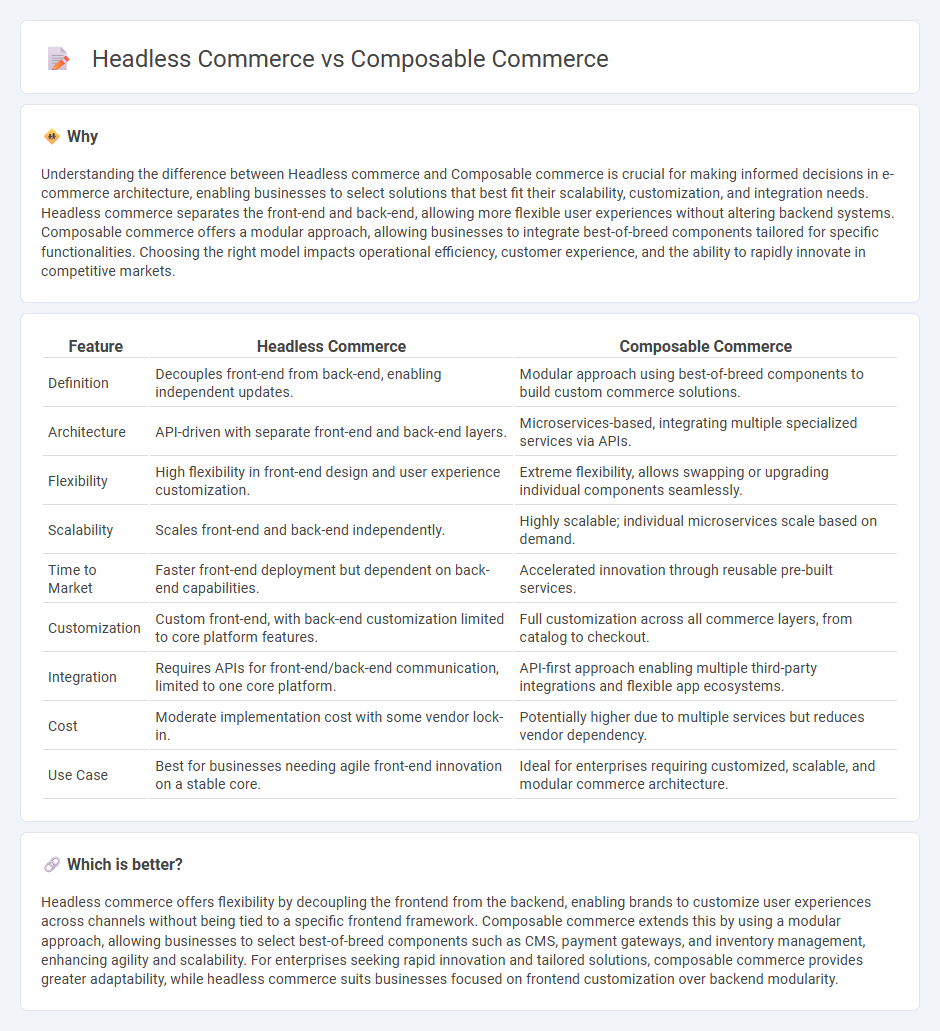
Headless commerce separates the frontend presentation layer from the backend e-commerce functionality, enabling customized user experiences across multiple channels through API integrations. Composable commerce takes this modular approach further by allowing businesses to assemble best-of-breed components--such as payment processing, inventory management, and CMS--into a tailored commerce solution that enhances scalability and flexibility. Explore the differences and benefits of headless and composable commerce to optimize your digital retail strategy.
Why it is important
Understanding the difference between Headless commerce and Composable commerce is crucial for making informed decisions in e-commerce architecture, enabling businesses to select solutions that best fit their scalability, customization, and integration needs. Headless commerce separates the front-end and back-end, allowing more flexible user experiences without altering backend systems. Composable commerce offers a modular approach, allowing businesses to integrate best-of-breed components tailored for specific functionalities. Choosing the right model impacts operational efficiency, customer experience, and the ability to rapidly innovate in competitive markets.
Comparison Table
| Feature | Headless Commerce | Composable Commerce |
|---|---|---|
| Definition | Decouples front-end from back-end, enabling independent updates. | Modular approach using best-of-breed components to build custom commerce solutions. |
| Architecture | API-driven with separate front-end and back-end layers. | Microservices-based, integrating multiple specialized services via APIs. |
| Flexibility | High flexibility in front-end design and user experience customization. | Extreme flexibility, allows swapping or upgrading individual components seamlessly. |
| Scalability | Scales front-end and back-end independently. | Highly scalable; individual microservices scale based on demand. |
| Time to Market | Faster front-end deployment but dependent on back-end capabilities. | Accelerated innovation through reusable pre-built services. |
| Customization | Custom front-end, with back-end customization limited to core platform features. | Full customization across all commerce layers, from catalog to checkout. |
| Integration | Requires APIs for front-end/back-end communication, limited to one core platform. | API-first approach enabling multiple third-party integrations and flexible app ecosystems. |
| Cost | Moderate implementation cost with some vendor lock-in. | Potentially higher due to multiple services but reduces vendor dependency. |
| Use Case | Best for businesses needing agile front-end innovation on a stable core. | Ideal for enterprises requiring customized, scalable, and modular commerce architecture. |
Which is better?
Headless commerce offers flexibility by decoupling the frontend from the backend, enabling brands to customize user experiences across channels without being tied to a specific frontend framework. Composable commerce extends this by using a modular approach, allowing businesses to select best-of-breed components such as CMS, payment gateways, and inventory management, enhancing agility and scalability. For enterprises seeking rapid innovation and tailored solutions, composable commerce provides greater adaptability, while headless commerce suits businesses focused on frontend customization over backend modularity.
Connection
Headless commerce and composable commerce share a modular architecture that enhances flexibility and scalability in online retail systems. Both approaches decouple front-end presentation from back-end commerce functionalities, allowing businesses to integrate best-of-breed components via APIs. This connection enables faster innovation cycles and personalized customer experiences by leveraging interchangeable microservices in a unified commerce ecosystem.
Key Terms
API-first
Composable commerce leverages API-first architecture to enable flexible, modular components allowing businesses to tailor digital experiences rapidly. Headless commerce separates frontend and backend systems with APIs, providing seamless integration and customization across multiple channels. Explore the differences and benefits of API-first strategies in composable and headless commerce to optimize your eCommerce platform.
Modular architecture
Composable commerce leverages modular architecture to enable businesses to assemble best-of-breed components into a customized eCommerce solution, offering unparalleled flexibility and scalability. Headless commerce decouples the front-end from the back-end using APIs, allowing seamless integration of diverse systems but often relies on less granular building blocks than composable frameworks. Explore how modular architecture drives innovation and agility in commerce by diving deeper into composable and headless strategies.
Frontend-backend decoupling
Composable commerce and headless commerce both emphasize frontend-backend decoupling, allowing businesses to customize and scale their digital storefronts independently from backend systems. Composable commerce integrates modular services and APIs for flexible assembly of commerce components, whereas headless commerce decouples the presentation layer from backend functionalities to enable seamless multichannel experiences. Explore the advantages and practical applications of these architectures to optimize your e-commerce strategy.
Source and External Links
Headless vs. Composable Commerce: Key Differences - Composable commerce optimizes commerce ecosystems by using discrete, API-connected modules tailored to specific business needs, leveraging MACH technologies for flexibility and scalability.
What Is Composable Commerce? | Salesforce US - Composable commerce is a modular, API-driven approach that enables businesses to mix and match plug-and-play capabilities to quickly and cost-effectively create unique digital storefront experiences across channels.
Composable Commerce: What It Means and Is It Right for You? (2024) - Composable commerce is a modular ecommerce architecture allowing businesses to assemble best-in-class technological components into tailored solutions, emphasizing flexibility and agility over monolithic systems.
 dowidth.com
dowidth.com